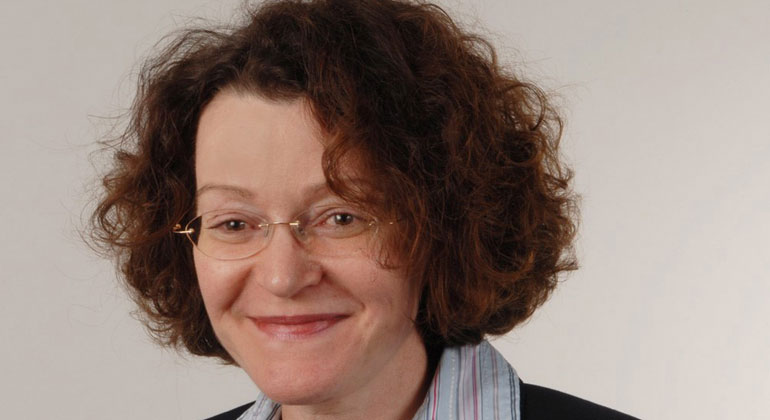The beginning of a revolution in packaging
Humankind has already produced more than eight billion tons of plastic. Every year, we add another 80 million tons of plastic packaging to the total, only half of which is recycled.
The rest ends up in a garbage incinerator or as trash that pollutes forests, meadows, lakes and oceans. Dr. Sabine Amberg-Schwab from the Fraunhofer Institute for Silicate Research ISC in Wurzburg is on to something that could solve the problem – a new class of material called bioORMOCER®s.
Congratulations, Dr. Amberg-Schwab. You developed a biodegradable, compostable barrier coating and earned a New Plastics Innovation Prize for your efforts. Is this the beginning of a revolution in packaging?
We have been looking into the global problem of packaging waste for a long time now here at the ISC. We are proud to be making a valuable contribution towards reducing the mountain of plastic waste with our research. But I wouldn’t call it a revolution in packaging. We have decades of experience developing ORMOCER®-based barrier layers for packaging films, so it was a logical step for us to research organically-based, biodegradable coatings for films.
With this newly developed class of materials – bioORMOCER®s – you are not only making up for bioplastics’ shortcomings; you’re actually enhancing them. Can you explain this?
Biodegradable and compostable packaging materials made of cellulose, polylactide or starch blends have long been on the market. However, these biopolymers are of limited use because they cannot properly protect food against moisture and oxygen. These materials are too permeable to moisture, oxygen, carbon dioxide and flavorings. Biopolymers cannot guarantee the minimum shelf life required for foods, so we upgraded these bioplastics with special organically-based, biodegradable coatings to improve their properties. They now provide sufficient protection to prevent moisture, gas and foreign substances from entering the packaging’s contents. We want to make compostable polymer films competitive and help them to become a widely available commodity.
Have you already brought your new product to market?
We have developed the first compostable coatings and applied them to films. These films have all the desired properties; for example, they serve as a barrier to moisture and oxygen. When no longer needed, the coated film decomposes completely under composting conditions.
How long will it be before we can buy cheese, chips and other groceries in compostable packaging coated with bioORMOCER®s?
First we have a major packaging challenge to contend with. Conventional, fossil-fuel-based plastic packaging is extremely cheap, very advanced and has been optimized. Our new materials cannot yet compete in terms of price. Even so, I am optimistic: We developed the basic material system; now we are looking for companies to pursue the idea with us. The prospects certainly look good: We are engaging in a twelve-month accelerator program that is part of the Circular Materials Challenge, where we won the New Plastic Innovation Prize. This puts us in touch with companies that are also interested in developing sustainable packaging materials. Our first new compostable coating materials are available now for trials and further optimization.
What does your invention mean for nature and the environment in the long term?
Our approach helps the environment in two ways. We’re tapping organically based source compounds. And we can use food waste or by-products from food production for our coatings. This conserves global resources. What’s more, bioORMOCER®s are biodegradable and compostable, unlike the fossil-based plastic materials used today, which degrade very slowly or not at all in nature. The consequences of this can be seen in the plastic that carpets the world’s oceans, for example.
An unorthodox question to close: Wouldn’t it be best to stop using packaging materials altogether?
That’s right; we should try to avoid packaging wherever we can. But that is not going to work across the board. For a real revolution in packaging, we will have to have several legs to stand on. Developing compostable packaging. Keeping packaging in circulation, recycling and avoiding packaging.
Andrea Schwendemann conducted the interview.
- Research News September 2018 – The beginning of a revolution in packaging [ PDF 0.51 MB ]
- Fraunhofer Institute for Silicate Research ISC
…………………………………………………………………………………………………………………………………………
Biological coatings
The Fraunhofer Institute for Silicate Research ISC in Wurzburg has a long and successful track record developing barrier coatings based on ORMOCER®s (inorganic-organic hybrid polymers). This class of materials’ barrier properties are good at keeping out gases, moisture and aromas. bioORMOCER®s, where biodegradable components of organic origin replace non-biodegradable organic components from fossil sources, are the next evolutionary stage of this development. This year, ISC researcher Dr. Sabine Amberg-Schwab and her team won the Circular Materials Challenge at the World Economic Forum in Davos, taking home the New Plastic Innovation Prize for their invention.
It is sponsored by the Ellen MacArthur Foundation and a sizable group of supporters that includes prestigious companies, NGOs and private sponsors. An EU project called HyperBioCoat is making further strides in this area. The Fraunhofer Project Group for Material Cycles and Resource Strategy IWKS is coordinating this joint project with twelve industry and research partners.









